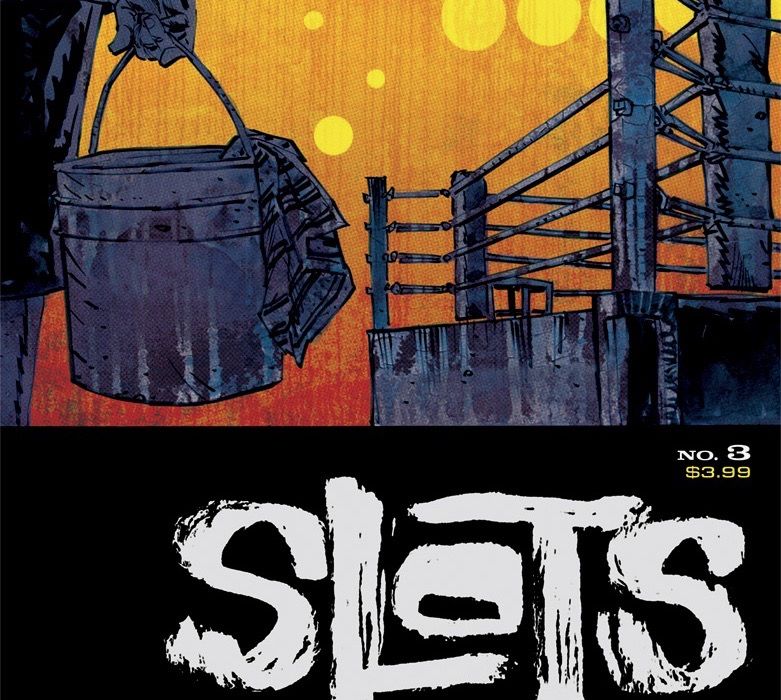Time for Stanley’s big comeback as father and son share billing on the hottest fight card in town. Meanwhile, the series itself evolves into a true ensemble piece as members of the supporting cast jockey for position in creator Dan Panosian’s wonderfully realized Las Vegas. (Warning: minor spoliers ahead.)
Written, Illustrated andCover by Dan Panosian
Colored by Dan Panosian
Lettered by Pat BrosseauWhat’s more dangerous than a psychic at a poker table? An angry casino realizing the house doesn’t always win.
In many ways, the protagonist and main character of “Slots,” Stanley Dance, is the definitive antihero. He’s selfish, he’s lazy, he makes consistently poor choices and he’s relentlessly opportunistic. That said, he may be the primary focus, but he’s hardly the only one to thrive in the morally ambiguous gray area of the faded glory that is Dan Ponosian’s impeccably rendered version of Las Vegas.
Honestly, I’m not sure which came first, Panosian’s decision to set the series in so-called Glitter Gluch or the idea for his richly imagined and unique cast of characters. In the end, it doesn’t matter. They are so intertwined that neither could exist without the other, a fact that becomes more apparent with each passing issue. The setting largely defines who the characters are – what they think, feel and do – while the characters in turn shape the setting, encapsulating and even distinguishing its decidedly gritty look and feel. Character, time, place and action all become one and the same, as though Stanley’s ever-present stubble and smart ass grin are as much a fixture of the landscape as the various casino marquees and billboards.
Narratively, the central plot line of “Slots” #3 is Stanley’s much anticipated “come back” boxing match. For many comic creators that would be plenty of content for a single issue, but Panosian doesn’t stop there. Stanley’s formerly estranged son Lucy (“Sue was already taken,” Stanley flatly tells the burlesque dancer Mercy) also happens to be headlining the very same fight card as his father. And there’s a detailed subplot involving two other important characters and key facets of their backstory which will doubtlessly ensnare Stanley somewhere down the line.
In the best possible way, this similarly structured three chapter (three act) installment feels like an episode of a fast paced, high quality, ensemble TV show. We really get to know more about each of the key characters while the overall story arc beautifully interweaves multiple threads and themes without ever feeling rushed or hokey.
More than anywhere else, this is where Panosian’s proficiency shows. With years of experience working on comic books at multiple publishers, he has also worked in advertising and as a storyboard artist, not to mention game design for the infamous Duke Nukem. Clearly, the man thoroughly understands the mechanics of sequential art. In this, his first creator owned comic, that confidence shines through. His paneling and visual rhythm are particularly adept, moving effortlessly from wide establishing shots to close-up facial reactions with ease and efficiency. Panel and page compositions are regularly packed with relevant details, yet don’t feel crowded, omitting unneeded distractions.
Panosian’s color palette is similarly clean and uncomplicated yet utterly fitting. The colors are mostly muted, evoking the bygone glory days of the characters and the city. In fact, other than speech balloons (which are angular and geometric, never curved), white is nonexistent. Instead, the negative spaces, panel borders and gutters have the yellowed, almost brittle look of newspapers found in the attic, ready to crumble at the slightest touch. Interestingly, this gives the entire book a strange, dualistic quality that makes it simultaneously feel both historic and immediate. The events are somehow mythic and larger than life, even as we watch them unfold, in real time, right before our eyes.
Admittedly, it’s hard to believe that we’re only three issues into the run. Panosian has introduced so many characters, each with their own compelling backstories, subplots, goals and relationships to each other that it’s not entirely clear exactly where things are headed. As with any ensemble piece, we could easily go down one road for a while, only to rejoin another character in an unexpected place.
As noted at the top, clearly the action centers on the lovable loser Stanley Dance. With an interesting array of other characters around him, however, it’s fascinating to speculate who will pull him in which direction and for what ultimate purpose. Thankfully, that seems perfectly fitting in the seedy, seamy, always-on-the-make Las Vegas that Panosian has constructed. Some series tend to stagger beneath the weight of too many characters, too many subplots and too many ideas. “Slots” is not one of them. Stanley Dance has been the focus to this point, but as the cliffhanger suggests, the ways in which these characters might interact and rearrange and redefine themselves are practically endless. We’ve barely scratched the surface.
Final verdict 8.5 – In only the third issue, “Slots” has hit its stride, opening up an array of intriguing possibilities that are refreshingly hard to predict.




